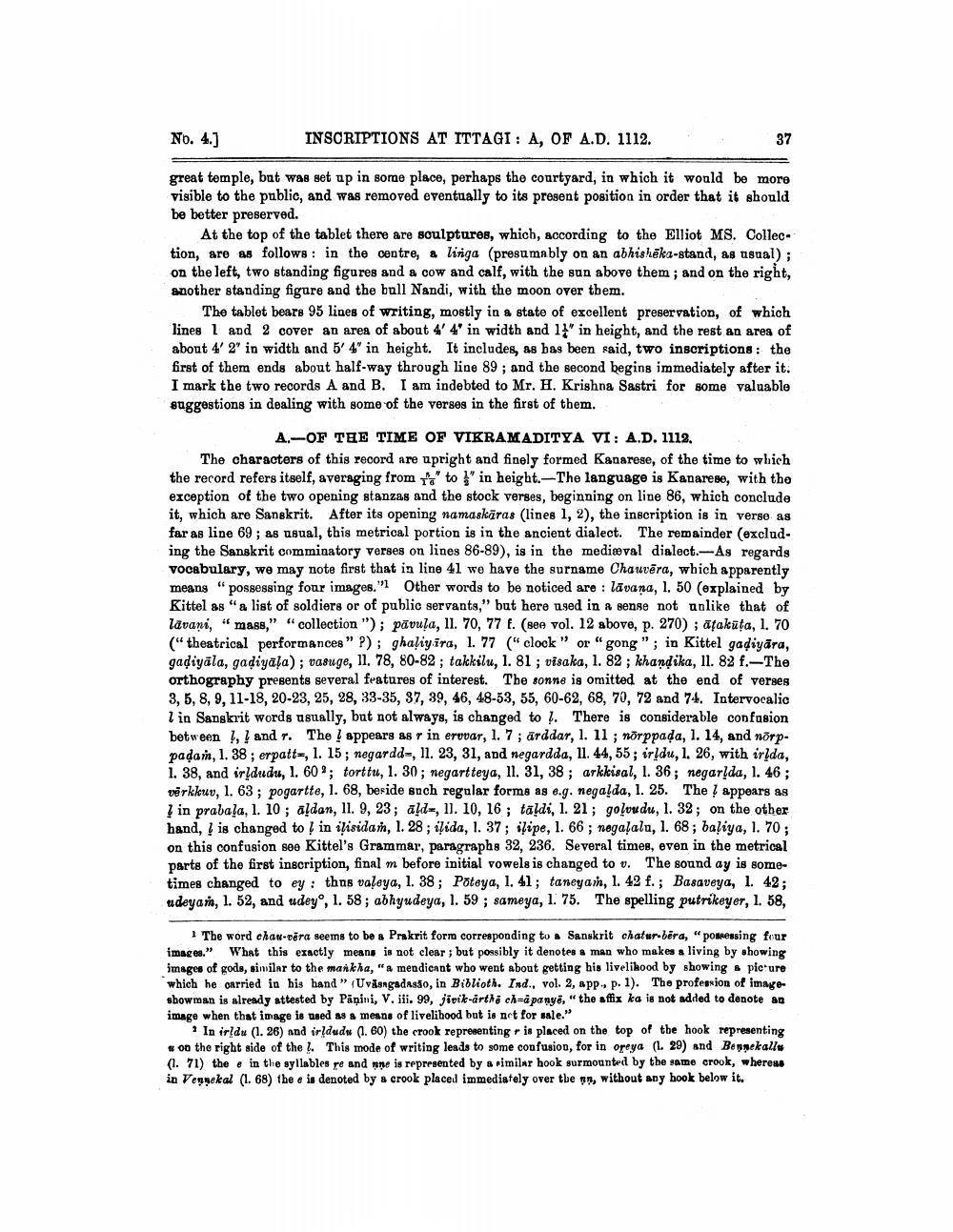________________
No. 4.]
INSCRIPTIONS AT ITTAGI: A, OF A.D. 1112.
great temple, but was set up in some place, perhaps the courtyard, in which it would be more visible to the public, and was removed eventually to its present position in order that it should be better preserved.
37
At the top of the tablet there are sculptures, which, according to the Elliot MS. Collection, are as follows: in the centre, a linga (presumably on an abhisheka-stand, as usual); on the left, two standing figures and a cow and calf, with the sun above them; and on the right, another standing figure and the bull Nandi, with the moon over them.
The tablet bears 95 lines of writing, mostly in a state of excellent preservation, of which lines 1 and 2 cover an area of about 4' 4" in width and 11" in height, and the rest an area of about 4' 2" in width and 5' 4" in height. It includes, as has been said, two inscriptions: the first of them ends about half-way through line 89; and the second begins immediately after it. I mark the two records A and B. I am indebted to Mr. H. Krishna Sastri for some valuable suggestions in dealing with some of the verses in the first of them.
A.-OF THE TIME OF VIKRAMADITYA VI: A.D. 1112.
The characters of this record are upright and finely formed Kanarese, of the time to which the record refers itself, averaging from" to " in height. The language is Kanarese, with the exception of the two opening stanzas and the stock verses, beginning on line 86, which conclude it, which are Sanskrit. After its opening namaskaras (lines 1, 2), the inscription is in verse as far as line 69; as usual, this metrical portion is in the ancient dialect. The remainder (excluding the Sanskrit comminatory verses on lines 86-89), is in the medieval dialect.-As regards vocabulary, we may note first that in line 41 we have the surname Chauvera, which apparently means "possessing four images." Other words to be noticed are: lavana, 1. 50 (explained by Kittel as "a list of soldiers or of public servants," but here used in a sense not unlike that of lavani, "mass," "collection "); pāvula, 11. 70, 77 f. (see vol. 12 above, p. 270); aṭakuṭa, 1. 70 ("theatrical performances" ?); ghaliyara, 1. 77 ("clock" or "gong"; in Kittel gaḍiyāra, gaḍiyala, gaḍiyāla); vasuge, 11. 78, 80-82; takkilu, 1. 81; visaka, 1. 82; khandika, 11. 82 f.-The orthography presents several features of interest. The sonne is omitted at the end of verses 3, 5, 8, 9, 11-18, 20-23, 25, 28, 33-35, 37, 39, 46, 48-53, 55, 60-62, 68, 70, 72 and 74. Intervocalic 7 in Sanskrit words usually, but not always, is changed to . There is considerable confusion between, and r. The appears as r in ervvar, 1. 7; arddar, 1. 11; norppada, 1. 14, and nōrppadam, 1. 38; erpatt-, 1. 15; negardd-, 11. 23, 31, and negardda, 11. 44, 55; iridu, 1. 26, with irlda, 1. 38, and iridudu, 1. 602; torttu, 1. 30; negartteya, 11. 31, 38; arkkisal, 1. 36; negarlda, 1. 46; verkkuv, 1. 63; pogartte, 1. 68, beside such regular forms as e.g. negalda, 1. 25. The appears as in prabala, 1. 10; aldan, 11. 9, 23; ald, 11. 10, 16; tāldi, 1. 21; golvudu, 1. 32; on the other hand, is changed to l in ilisidam, 1. 28; ilida, 1. 37; ilipe, 1. 66; negalalu, 1. 68; baliya, 1. 70; on this confusion see Kittel's Grammar, paragraphs 32, 236. Several times, even in the metrical parts of the first inscription, final m before initial vowels is changed to v. The sound ay is sometimes changed to ey: thus valeya, 1. 38; Poteya, 1. 41; taneyam, 1. 42 f.; Basaveya, 1. 42; udeyam, 1. 52, and udey°, 1. 58; abhyudeya, 1. 59; sameya, 1. 75. The spelling putrikeyer, 1. 58,
1 The word chau-vera seems to be a Prakrit form corresponding to a Sanskrit chatur-bera, "possessing four images." What this exactly means is not clear; but possibly it denotes a man who makes a living by showing images of gods, similar to the mankha, "a mendicant who went about getting his livelihood by showing a picture which he carried in his hand" (Uväsngadasão, in Biblioth. Ind., vol. 2, app., p. 1). The profession of imageshowman is already attested by Panini, V. iii. 99, jivik-arthi ch-apanye, "the affix ka is not added to denote an image when that image is used as a means of livelihood but is net for sale."
In iridu (1. 26) and iridudu (1. 60) the crook representing r is placed on the top of the hook representing # on the right side of the . This mode of writing leads to some confusion, for in oreya (1. 29) and Bennekallu (1.71) the e in the syllables re and nne is represented by a similar hook surmounted by the same crook, whereas in Vennekal (1. 68) the e is denoted by a crook placed immediately over the nn, without any hook below it.




